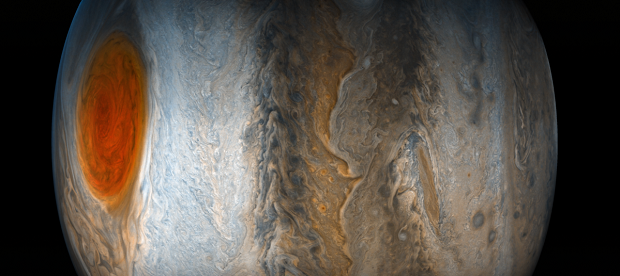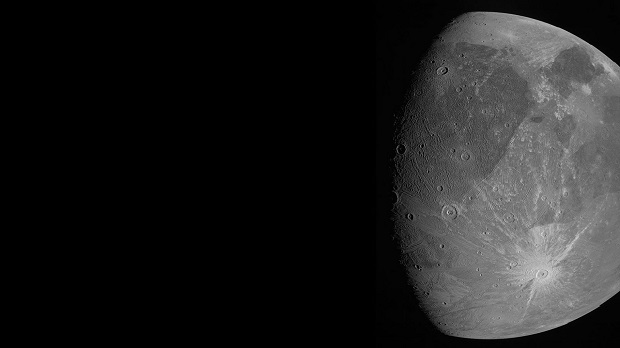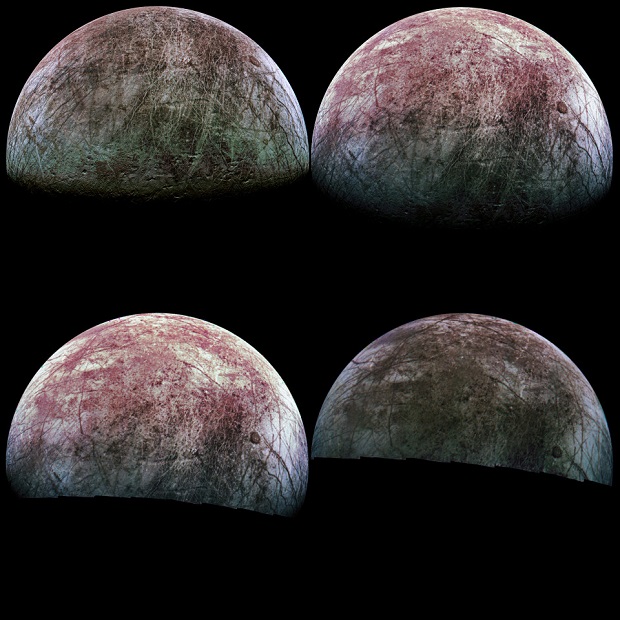
Ganymede's shadow on Jupiter: Juno Interplanetary Station takes beautiful picture
During its 40th approach to Jupiter, the Juno interplanetary station took a beautiful picture that shows the shadow cast by the moon Ganymede on Jupiter.
According to NASA, the JunoCam took the image at close range, which makes the shadow from the satellite appear particularly large. The raw image was taken on Feb. 25, 2022: At that time, "Juno" was about 71,000 kilometers above the tops of Jupiter's clouds and was 15 times closer to the planet than Ganymede.

Jupiter is a bright gas giant
Jupiter, the largest planet in the solar system, is classified as a gas giant. Such planets consist mostly of hydrogen and helium, and the heavier elements in them are no more than 3-13% of the total mass.
Jupiter, as far as is currently known, has no solid surface. What then are the bright stripes that can be seen in all pictures of the planet? There are several versions to explain the origin of these bands. According to one of them, the bright stripes appeared as a result of convection in the planet's atmosphere, when some layers, heating up, rose higher, and others, cooling down.
According to another hypothesis, the bands were formed under the influence of satellites and their gravitational force.
Another interesting phenomenon that can be seen in many images of Jupiter is the so-called Great Red Spot. Most likely, it is a permanent atmospheric formation, a giant vortex, the substance in which rotates counterclockwise. A complete revolution it makes in 6 Earth days. The spot is several times larger than the Earth and has been observed for over 300 years.
However, the size and shape of the Great Red Spot varies. Currently, its size is 15 x 30 thousand kilometers (for comparison, the diameter of the Earth is about 12.7 thousand km), and 100 years ago, its dimensions were two times larger.
This is what the Great Red Spot looks like in a photo of "Juno" taken on July 10, 2017, from 16,535 km above Jupiter's atmosphere:

Solar eclipses on Jupiter
If someone had been on top of the clouds of Jupiter at the moment when "Juno"took the picture with the shadow of Ganymede, they would have seen a total eclipse: Ganymede would have eclipsed the Sun.
Jupiter has more total eclipses than Earth. The planet has about 80 satellites, but the 4 largest - Ganymede, Io, Callisto and Europa - quite often pass between Jupiter and the Sun, casting shadows on the planet.
"Juno" and Jupiter
Both ground-based and orbiting telescopes and stations are exploring Jupiter, and "Juno" is one of them, along with Galileo, Pioneers, Voyager and other NASA interplanetary spacecraft.
"Juno" was launched in August 2011 and during its operation took a lot of pictures, which provided a lot of interesting information about the gas giant, its internal structure, magnetic field and its satellites.
On June 7, 2021 an image of Ganymede was taken with high detail, where you can see the light and dark areas of the surface and tectonic cracks on it.

On September 29, 2022, "Juno" flew over another satellite of Jupiter, Europa, whose surface is covered in ice at an altitude of only 352 km.

"Juno" is expected to operate in the Jupiter system until 2025, or until its end of life if the spacecraft passes its end of life sooner.
- Related News
- The end of the Universe: 3 plausible theories of a global apocalypse
- Mutated bacteria resistant to drugs found on the ISS: What does this mean and why is it a problem?
- 4 flares erupted from Sun in rare event: the Earth may be hit by geomagnetic storm (video)
- 11 incredible satellite photos published on Earth Day
- NASA shows all of Ingenuity's flight trajectories in one video
- Could life exist on Saturn's moon Enceladus?
- Most read
month
week
day
- Once in a lifetime phenomenon: This year we will observe a star explosion that occurred 3,000 years ago 907
- Meta unveils Llama 3 and claims it's the "most powerful" open source language model 900
- WhatsApp to integrate AI function: What will it do? 842
- Google fires 28 employees who protested against company's cooperation with Israel 818
- iPhone 17 Plus will have smaller screen 770
- 5 best smartphones with IPS screens 753
- How DNA analysis helps to solve crimes and who can sell your DNA data and why: Interview with former FBI scientist Bruce Budowle 735
- Huge battery, IP68/IP69K and MIL-STD-810H certifications: Ulefone will present the Armor Pad 3 Pro tablet (photo) 716
- Sentry Enterprise presents first bank card with screen: How does it work? 609
- What risks do crypto and digital currencies pose? Interview with Rasmus Nielsen 580
- Archive
